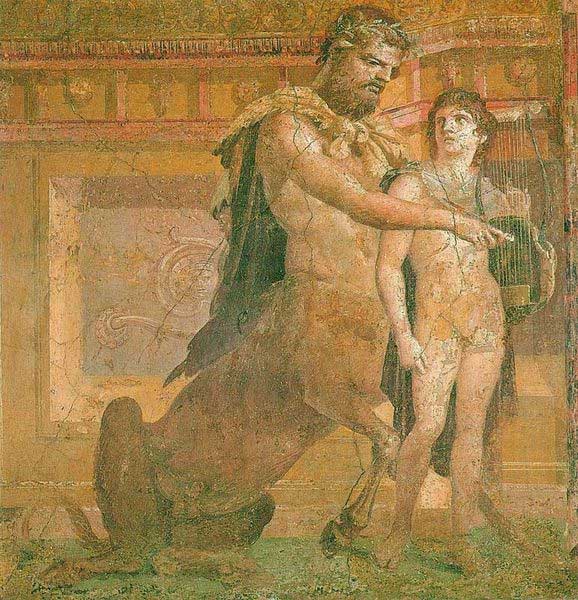.

Chiron and Achilles from Herculaneum.
Chiron, with a wreath of laurel about his head, with an expression of face both noble and kindly, has passed his left hand behind the shoulders of Achilles in order to hold the lyre, that the attention of the youth may be given wholly to the lesson ; with the fingers of the right hand he lightly grasps the plectron. Achilles stands with face turned toward the master's in rapt attention ; his right hand hangs by his side. His attitude and expression are happily characterized by Winckelmann, who saw the painting when it was fresher than now ; yet, all things considered, it has been remarkably well preserved. "Achilles," says this critic, "stands in an attitude of rest and composure, but in the face there is much suggestiveness ; the lineaments give promising indications of the future hero, and in the eyes, which are fixed with earnest attention upon Chiron, we read an impatient desire to receive instruction and bring to an end the course of youthful training that he may make memorable with great deeds the short tale of years allotted to him. On his forehead sits a noble shame, a rebuke of his own backwardness, because the master has taken the plectron from his hand in order to correct his mistakes. He is beautiful in the Aristotelian sense ; the sweetness and charm of youth are blended with pride and sensitiveness."
While in the representations of other centaurs the brute nature is made more prominent, in Chiron the human element from the beginning had the ascendency. This was in accordance with the literary tradition from Homer down ; so wise was Chiron, bridger of the gap between man and nature, that he became the teacher and trainer, not only of Achilles, but of a list of heroes so long that it reads like the honor roll of a famous college. In Greek vase-paintings after the early inorganic joining of a human body with human feet to the barrel of a horse's body with a horse's hind feet was abandoned in the case of the other centaurs, in representations of Chiron it was still continued for a considerable time, thus evidencing the prominence of the human side in the minds of the designers ; "while the general horde of centaurs, both Thessalian and Arcadian, including Pholos himself, have become horses with only the heads and chests of men, Cheiron is a draped philosopher encumbered with half a horse a tergo."
The Chiron of our painting, as we should expect in the case of a late representation, has a body like that of the other centaurs, but the prominence of the human element in his nature is no less marked; he is the wise and gentle teacher, the instructor of an art. Yet the huge bulk of horse-body is not obscured ; instead of being thrown into the background it slopes conspicuously down to the pavement where it is supported by the haunches. The rear of the picture shows a wall, painted yellow, with a cornice divided off by stripes into sections in which rosettes alternate with bucrania. This may possibly be a free rendering of a portion of the Saepta; that the group mentioned by Pliny is reflected in the painting can hardly be doubted.
Nor can we doubt that in Juvenal's time the mention of Chiron, in such a connection as that of the passage in the third Satire, would suggest the group of Chiron and Achilles, whether it called to mind the masterpiece in the Saepta, or the numerous representations in wall paintings, reliefs and gems.
We need not be surprised that the poet should designate the group by the name Chiron alone, instead of Chiron and Achilles ; Juvenal wastes no words, and it would be natural to call such a work after the dominant figure, just as we speak of the " Farnese Bull." Thus Martial, consistently with what we may believe to have been current usage, designates the group of Chiron and Achilles in the Saepta by another name for Chiron, Phillyrides. In speaking of the Saepta, Juvenal uses not this word but the old-fashioned ovile, " sheepfold."
Assuming that the Chiron of Juvenal is a diminutive copy of the group in the Saepta, we see that the shape of the figure of the centaur, more prominent in front and sloping back toward the rear, and the pose of the Achilles, made it especially suitable for display on a shelf or base under the marble top of the abacus. Moreover recubans, humorously applied to the posture of the horse-body, with this interpretation becomes not only intelligible but characteristically Juvenalian. Finally' no subject would be more in keeping with the surroundings of a man of poetic tastes than that of instruction by Chiron, guardian of the secrets of nature, teacher of music, the beneficent. Francis W. Kelsey.
See also : Greek Mythology. Paintings, Drawings
| Ancient Greece
Science, Technology , Medicine , Warfare, , Biographies , Life , Cities/Places/Maps , Arts , Literature , Philosophy ,Olympics, Mythology , History , Images Medieval Greece / Byzantine Empire Science, Technology, Arts, , Warfare , Literature, Biographies, Icons, History Modern Greece Cities, Islands, Regions, Fauna/Flora ,Biographies , History , Warfare, Science/Technology, Literature, Music , Arts , Film/Actors , Sport , Fashion --- |
Retrieved from "http://en.wikipedia.org"
All text is available under the terms of the GNU Free Documentation License

